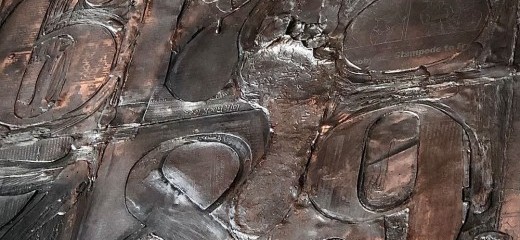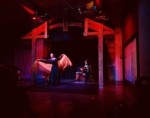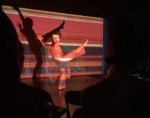
Footprints of Abstract Dance: a three-part variation
by Anito Gavino
Initially, I was to write a review on Pam Tanowitz’s choreography created in honor of Jasper Johns. Many iterations of review-writing later, two pages tripled into an experimental think piece. This review is inspired by Johns’ postmodern method of variating a piece of art to make many more pieces of art.
To give context, I am a Filipinx immigrant artist who has internalized a felt sense of being silenced by colonialism and white supremacy. Thus, I took the challenge of writing this piece as a journey towards my own decolonial voice within dance writing. The stages of this journey are manifested in three variations.
Pictured above: a cropped photo of Johns' Numbers (1964) displaying a cast iron of Merce Cunningham's footprint.
Pictured on homepage: a cropped photo of Johns' work deconstructing John Cage's score and sheet music from his composition Perilous Night.
Variation 1:
In December 2021, I witnessed an exhibit at the Whitney Museum of Art reviving Jasper Johns’ work, Jasper Johns: MIND/MIRROR. One sculpture caught my eye: Numbers (1964) , a sculpt-metal on canvas commissioned for the Lincoln Center and displayed to this day in the New York State Theater. The tour guide told the story of how Johns casted Merce Cunningham’s footprint on the metal sculpture, a promise to get Cunningham’s foot into the New York State Theater door.
In January 2022 at the Philadelphia Museum of Art (PMA), Johns’ work was also honored. America has missed Johns so much that his work was accompanied by dance performances, one of which was by Pam Tanowitz, who choreographed Finally Unfinished (Solo for Melissa for Jasper), performed by Melissa Toogood, a former Cunningham dancer.
I respect the duration of Tanowitz's exploration and Toogood’s commitment to controlling the large space with her singular body. Toogood performed movements in the ballet vocabulary, stylized. There were repetitions and variations to phrases of movement, similar to Cunningham’s way of choreographing. Toogood used the same quick staccato movements down the staircase in the PMA’s Williams Forum and onto the first stage where she stripped off a piece of her costume. These footwork movements reminded me of a modern version of a petit allegro ballet phrase. The same series of footwork was done while she laid on her back, knees pointing up to the ceiling. She later took off her shoes and did flic flacs across the main stage. She added a blousy sheer top to her unitard costume and danced again. She finished by picking up her shoes and left the stage. This reminds me of my daughter’s younger years of play. Put on a costume. Dance. Take it off. Dance. Add a feather boa. Dance.
----------------------------------------------------------
Variation 2:
In January 2022, I experienced Johns’ work at the PMA. This durational exhibit showed his connections to other avant-garde artists in the era of postmodernism. For example, musician John Cage wrote a poem, Art is Either a Complaint or Do Something Else, in response to Johns’ work. This poem was played through speakers throughout the art gallery. Cage also is Cunningham’s long-time collaborator. Decades later, building off of these avant-garde artists, Tanowitz choreographed Finally Unfinished (Solo for Melissa for Jasper), inspired by Johns and performed by former Cunningham dancer, Melissa Toogood. I then wondered, in the world of avant-garde art, music, and dance, whose “feet” get into the door of validity, legacy, and fame? Can my flat feet enter the gates of fully funded dance?
Memories of Dr. Brenda Dixon Gottschild’s research, Digging the Africanist Presence in American Performance: Dance and Other Contexts, flood my thoughts. In her writing, Dr. Gottschild points out how Africanist aesthetics are embedded in Euro-American dance performance. The Africanist movements are obscured by ballet vocabularies, just like the shoulder shimmy in between petite allegros that I witnessed in Finally Unfinished.
In Johns’ words, “My work became a constant negation of impulses. I don't want my work to be an exposure of my feelings…” At a time of radical expression and rebellion from European classics, post-modernists such as Johns silenced their thoughts and feelings as a means of producing something “neutral.” Inspired by Johns’ approach, my thoughts and emotional responses to the work can be found in the footnotes1. Often, a voice like mine is deemed as small as a footnote on a page.
—Footnotes—
1. Finally Unfinished kept emotions, stories, and meanings hidden under a calm presentation of stoicism. As Toogood danced through the space, her countenance never betrayed the narratives brewing underneath. Since Tanowitz is riffing off of Johns’ work, I can assume his same ideas of decentering emotions are at play. The age of postmodernism created space to abandon narrative and musical composition, casting compositions from my indigenous diaspora as conventional, folky, elementary, traditional, ethnic, and non-academic.
2. It must be nice to experiment for experimentation's sake—to be abstract solely to explore composition. I do not have that privilege.
----------------------------------------------------------
Variation 3:
Stamped as trailblazers of experimental abstract dance from the 60s, choreographers including Anna Halprin, Trisha Brown, Yvonne Rainer, Twyla Tharp, Steve Paxton, Fred Herko, Lucinda Childs, and Merce Cunningham—white bodies in company with other white bodies—have defined what postmodernism is for the entire dance world. Jasper Johns, a visual artist who frequently collaborated with musicians and dance choreographers, prevailed on the visual art front. He was, however, working within a small bubble of white New York artists, each holding the keys to access. If art is a way to archive history, this cohort of postmodernists has done it. They were able to define what symbolisms should be in art-making through the coined term “abstraction.” Jasper Johns: MIND/MIRROR makes me think of those artists that mirror the image and likeness of his work.
Upon searching the definition of the word “abstraction,” there are distinctions between the application of the word from a Eurocentric usage versus that from the ethos of a Black and Brown perspective. The Oxford Dictionary states that abstraction is the act of detachment or removal from a source, for instance, the abstraction of water from springs. With this in mind, I completely understand why Johns makes art for art’s sake, believing that art should be devoid of emotions. Being devoid of emotions can either be an act of avoidance or of privilege. This is, however, different to artists whose life experiences are catalysts for art-making and whose art is a portal to spirit.
In February, I had the pleasure of attending the Collegium of African Diasporic Dance and witnessed a lecture by Tawanda Chabikwa, an interdisciplinary scholar whose work revolves around Black and Africana dance practices. He explained his own theory of abstraction, which is derived from one’s breath. This is the same mantra shared to me during my time working with Kun Yang-Lin who often spoke of Chi Awareness, while still utilizing choreographic modes from Laban, Forsythe, and other Western contemporary dance makers. I also ponder on the work of Dr. Ananya Chatterjea who challenges the definitions of contemporary by developing Yorchaa, a contemporary technique which merges some of her many dance languages—Odissi, Chauu, and Yoga—languages that can be deemed as “traditional” to the Wwestern eye. As another Asian Amercican dance scholar, I resonate with her dances and academic writing as these validate my own choreographic needs of connecting to my ancestral culture without being pigeon-holed as a traditional choreographer incapable of new imaginings. She uses emotionality to harness the body in telling the story. “Our padhas are abstractions for resistance.” So then, how does abstraction differ from the work of Cunningham to that of Chabikwa, Lin, and Dr. Chatterjea?
Abstraction is political. Throughout the COVID-19 pandemic, artists were creating works around isolation and police brutality towards Black lives. Artists and choreographers are inevitably affected by the state of the world. Then, I look back at the time of the 60s. Wasn't the Civil Rights Movement, post-Vietnam war, the Farm Labor movement, the Feminist movement, the Asian American and Latino movements, the Watts Rebellion, and East LA Walkouts all happening at this time? Weren’t race relations aggressively talked about in art and education? Weren’t the streets filled with brutality and chaos? To know that postmodern dance—absent of narrative—emerged at a time of darkness and tribulations is quite unsettling. Was America trying to quiet down the chaos and violence by utilizing abstract art and dance, all while claiming itself to be a leader of free expression?
As an immigrant from the Philippines, I painstakingly realized how dance–a source of freedom and expression—has been a gatekeeper of Eurocentricity. My analysis traces the footprints of impact from Johns to Cunningham—literally cementing his friend’s foot on his artwork—to exchanging ideas with Duchamp, John Cage, Trisha Brown, Pam Tanowitz and the list goes on. This is legacy gatekeeping in Western dance.
As a young Filipinx, I learned about this radical genre of postmodern dance-making booming in the United States. Two decades later after migration, I question such a reputation. I’ve heard dancers from non-European backgrounds express a disconnection with this type of abstract-making, particularly because of its esoteric nature, removed from intentionality and storytelling. “I often feel unintelligent for not liking it,” was the sentiment I recalled. Thus, I write this last paragraph in big bold letters to give space to this thought. Our thoughts, responses, and questioning can no longer be silenced in the footnotes. I am TAKING UP SPACE and UNAPOLOGETICALLY making room for the artists who are creatively making work outside the perimeters of these gatekeepers’ gates.
By Anito Gavino
June 7, 2022








